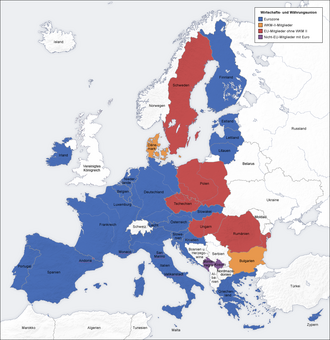Montenegro and the euro

Montenegro uses the euro as a means of payment . The country no longer has its own currency since the Kingdom of Montenegro came to an end and incorporated into Yugoslavia in 1918 .
Before the introduction of the euro in 2002, the German mark had been the de facto currency in all private and business transactions since the rapid devaluation of the Yugoslav dinar in the 1990s, while the dinar de jure was still in use until 2003. When the euro was introduced, Montenegro started using it as a currency. The European Central Bank (ECB) did not initially object to this step .
However, since then the European Commission and the ECB have expressed their dissatisfaction with Montenegro's unilateral use of the euro. The spokeswoman for the European Commission said in 2007 as follows: “The conditions for admission to the euro are clear. In other words, a country must at least first be a member of the EU. ”An appendix to the Stabilization and Association Agreement with the EU states:“ A unilateral introduction of the euro was not compatible with the treaty ”.
The EU insists on strict adherence to the convergence criteria (and e.g. membership of Exchange Rate Mechanism II for at least two years ), which are non-negotiable before the introduction of the euro. However, the EU did not intervene in Montenegro's unilateral use of the euro. However, it has expressed concerns about the sovereign debt of Montenegro, which in 2011 was 57% of gross domestic product .
Officials from the Central Bank of Montenegro have indicated on several occasions that the European institutions are pressing for compliance with WKMII rules, particularly as Montenegro is in the process of joining the EU. Nikola Fabris, the chief economist of the Central Bank of Montenegro, emphasized that the situation was very different when Montenegro unilaterally introduced the euro. Other states, such as Croatia and Bosnia and Herzegovina , which are considering a unilateral introduction of the euro, would face sanctions from the EU and their application for membership would be suspended if they continued.
On December 17, 2010, Montenegro was granted candidate status for EU membership. It is expected that this issue can be resolved through negotiation. The ECB has stated that the effects of the unilateral introduction of the euro would be addressed at the latest in possible negotiations on EU accession. Diplomats suggest that Montenegro is unlikely to be forced to abandon the euro as a means of payment. Radoje Žugić, the finance minister of Montenegro, said that "it would be economically irrational to return to a separate currency only to be accepted back into the euro later". Instead, he hopes that Montenegro will be allowed to keep the euro and he promised that "the government of Montenegro will meet some important conditions in order to keep the euro, such as compliance with fiscal rules".
Montenegro, which is in fact but not “officially” a member of the Eurozone , is therefore not allowed to mint any Euro coins with a country-specific design.
Individual evidence
- ↑ EU to question Montenegro's use of euro. October 8, 2007, accessed February 19, 2013 .
- ↑ a b EU warns Montenegro over Euro , B92 . October 10, 2007. Retrieved September 9, 2011.
- ↑ a b EU prijeti Crnoj Gori ukidanjem eura: Niste sposobni za našu valutu ( Croatian ) June 1, 2011. Accessed September 9, 2011.
- ↑ a b Montenegro Warns Against Unilateral Euro Adoption (Update1) , Bloomberg.com . April 21, 2009. Retrieved September 9, 2011.
- ↑ a b Montenegro's peculiar path to EU membership. February 7, 2013, accessed February 19, 2013 .